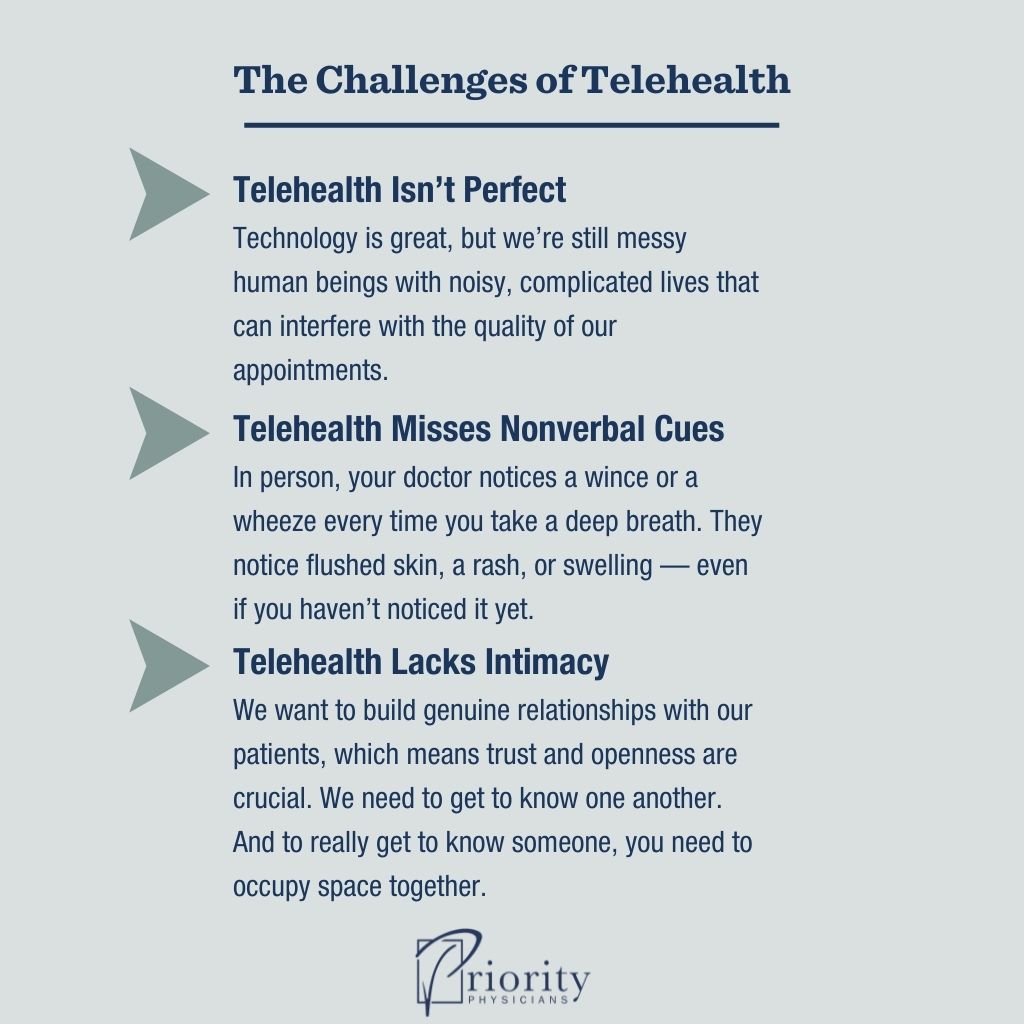Telehealth is an understandably exciting concept. You can video conference with your doctor from anywhere via the internet. You can avoid the waiting room. Telehealth is convenient. It fits into your busy life.
But in practice, telehealth has both benefits and challenges. Let’s talk about why telehealth is so popular, its pros and cons, and why our members overwhelmingly prefer meeting in person.
The Hype Around Telehealth
Even before the pandemic, telehealth was on the rise. In fact, we’ve used telehealth for decades. As communication and wearable technology have improved, it makes sense that telehealth has become more popular.
During the pandemic, however, telehealth exploded. Quarantines, restrictions, and risk of exposure made telehealth the only option for many people, and its increased prominence continues.
No doubt telehealth has its place in modern healthcare, but it has its drawbacks as well. Here are some telehealth benefits and challenges to consider before making all your appointments remote.
The Benefits of Telehealth
Video From Afar
One of the greatest benefits of telehealth is the reason it became so popular and widespread during the pandemic. You don’t have to be in the same room as your doctor. Or anyone, for that matter.
Being able to videoconference with your doctor from anywhere makes access to medical care incredibly convenient. This can be especially beneficial for people who travel often or live in rural areas.
Save on Travel Time
If you have a busy schedule or live far away from your doctor, telehealth eliminates your travel time. No more running out of work or sitting in traffic trying to get to your appointment on time.
You eliminate the commute, and you lose the stress that comes along with it.
Limited Exposure
Another benefit of telehealth — one that was crucial during the pandemic — was limiting exposure to others.
If you’re pregnant, elderly, or immunocompromised, going to the doctor can be risky. You’re exposed to a whole waiting room of people who could share their pathogens with you. But telehealth is the epitome of social distancing.
The Challenges of Telehealth
Telehealth Isn’t Perfect
One challenge of telehealth is that it’s not perfect. Technology is great, but we’re still messy human beings with noisy, complicated lives.
Say you’re videoconferencing from a device that has notifications popping up, chimes going off, windows open. Or your children or spouse are drawing your attention away. All of these things are distracting for you and your doctor and can interfere with the quality of the appointment.
Another challenge is privacy. If you have a hard time finding a quiet, private place (like a doctor’s exam room), you might not reveal as much in a telehealth call as you would in an in-person visit.
Telehealth Misses Nonverbal Cues
In person, your doctor notices a wince or a wheeze every time you take a deep breath. They notice flushed skin, a rash, or swelling — even if you haven’t noticed it yet.
But on a telehealth call, those symptoms don’t always come through. Sometimes nonverbal cues tell doctors the most about a patient’s health.
Telehealth Lacks Intimacy
We want to build genuine relationships with our patients, which means trust and openness are crucial. We need to get to know one another. And to really get to know someone, you need to occupy space together. Herein lies another challenge of telehealth.
The level of intimacy required for effective care between a doctor and patient is almost like that needed in marriage. Patients have to be comfortable sharing very personal details with their doctor. You can’t maintain a relationship with your spouse through FaceTime, and you shouldn’t try it with your doctor, either.
Telehealth lacks the intimacy necessary for effective healthcare. It creates just enough distance to prevent a real doctor-patient relationship from forming or continuing long term.

How Often Our Patients Use Telehealth
We do have some patients who are very excited about telehealth when they join our practice. However, nearly all of these patients use the telehealth option only once. With same-day appointments and a great relationship with their doctor available, they prefer in-office visits where they know they’ll get the best care possible.
Instead, our patients usually find phone calls (versus full telehealth appointments) to be an effective way of asking quick questions or refilling prescriptions. They save in-depth discussions on new health issues, for example, for face-to-face visits.
Why Our Patients Prefer To Meet in Person
At Priority Physicians, our patients prefer to meet in person because they like to see us. They like knowing that their doctors are here for them — and we are.
In-person meetings allow for chit-chat, for conversations through which we can uncover things going on in the patient’s world. This incidental information can give us insight into the patient’s symptoms or conditions. The nature of telehealth doesn’t facilitate such easy conversation, making such information far less likely to come through.
Our patients also enjoy the flexibility that comes with in-person meetings. If they’re a few minutes late to an in-person appointment, for example, it’s not a big deal. Maybe they feel rushed getting to the appointment, but once they get to the office, they can catch their breath and slow down.
Being late for a conference call is different. The minutes drag by, and you have no buffer between rushing to the computer and throwing yourself on the call. In such a flustered state, you might miss something or accidentally leave something out that your doctor really needs to know.
Finally, in-person meetings give patients a better opportunity to convey the severity of their ailment. And we, the doctors, can get a better understanding of the problem so that we can make an accurate diagnosis.
The Bottom Line
We are social beings who crave interaction. When you have an in-person meeting, you feel seen, heard, and understood. Spending time in the same space with another person really deepens a bond.
A screen just can’t give you that.
That’s not to say that every meeting or conversation has to be in person. You can still call, text, or videoconference if that’s what you need to do. But the more time your doctor spends with you in person, the better they get to know you. And the better your doctor knows you, your health history, and your concerns, the better they can provide the level of care you deserve.

